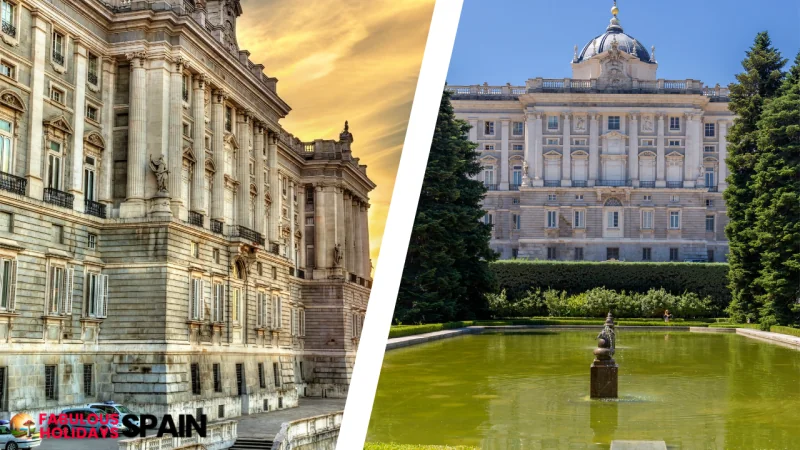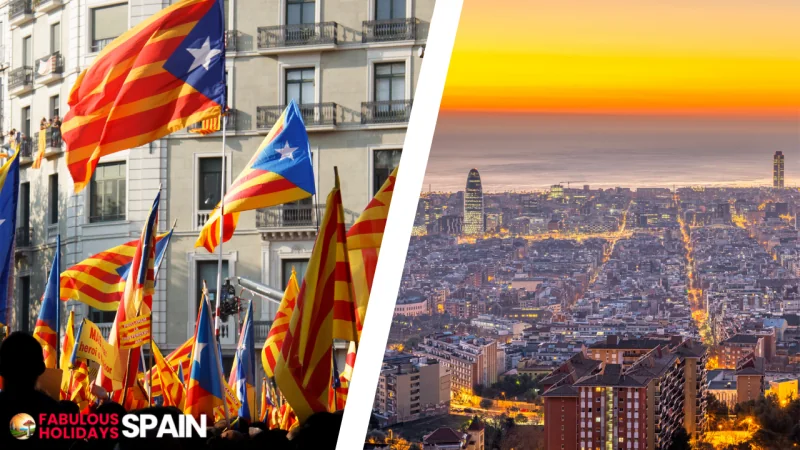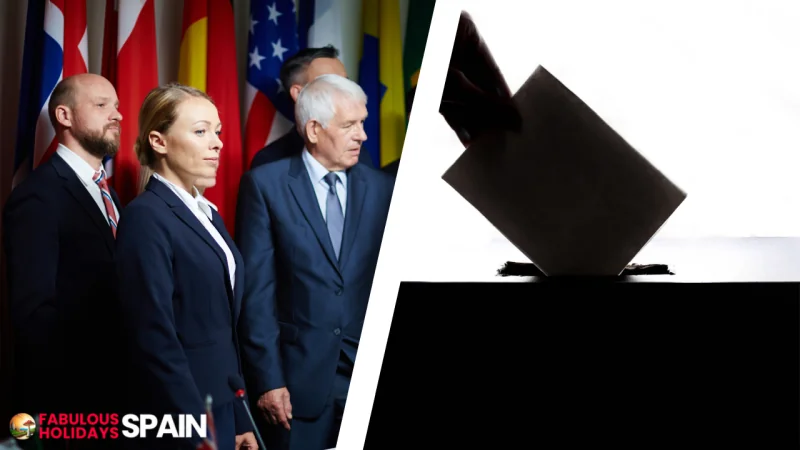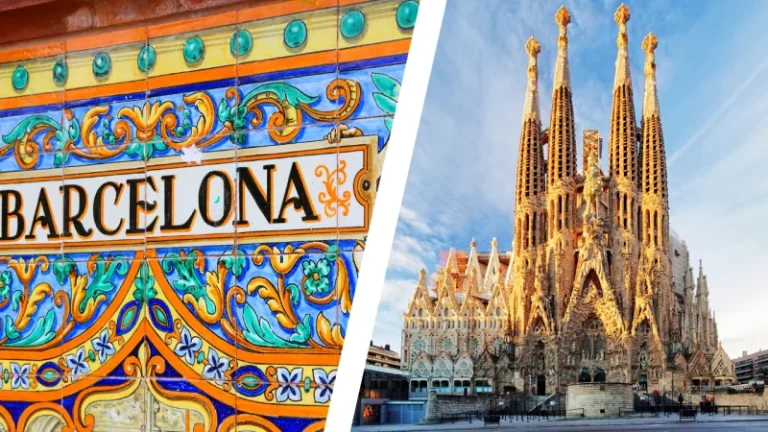What is the Spain Politics and Political Structure in Spain?
Spain politics takes place within the framework of the 1978 Constitution. In Spain, there is social and democratic sovereignty, where the powers of the state come from the people.
Spain’s political system is a multi-party system. In Spain, the Spanish Socialist Workers’ Party (PSOE) and the People’s Party (PP) have dominated politics since the 1990s.
In Spanish politics, regional parties play important roles, especially the Basque Nationalist Party (EAJ-PNV) from the Basque country and the Convergence and Union (CiU) and Republican Left of Catalonia (ERC) from Catalonia.
What is Spain’s form of government?
Spain’s form of government is a parliamentary monarchy, which is a type of constitutional monarchy in which the monarch serves as the head of state while the head of government is a prime minister who is responsible to the parliament.
What is the Political Structure in the Kingdom of Spain?
The Kingdom of Spain‘s political structure is defined by its constitutional monarchy, a system that combines a monarch as the head of state with a democratically elected government. This structure is outlined in the country’s constitution, which was adopted in 1978.
Who are the Members of the Spanish Royal Family?
The Spanish Royal Family is a branch of the House of Bourbon and is headed by King Felipe VI. The current members of the royal family are:

King Felipe VI: Felipe VI of Spain is the current King of Spain. He ascended to the throne on June 19, 2014, following the abdication of his father, King Juan Carlos I.
Queen Letizia: Queen Letizia is the wife of King Felipe VI. She is a former journalist and news anchor.
Princess Leonor, Princess of Asturias: Princess Leonor is the heir presumptive to the Spanish throne. She is the eldest daughter of King Felipe VI and Queen Letizia.
Infanta Sofía of Spain: Infanta Sofía of Spain is the second daughter of King Felipe VI and Queen Letizia.
King Juan Carlos I: King Juan Carlos I of Spain was the King of Spain from 1975 to 2014. He abdicated in favor of his son, Felipe VI, on June 19, 2014.
Queen Sofía of Spain: Queen Sofía of Spain was the wife of King Juan Carlos I of Spain. She is the daughter of King Paul of Greece and Queen Frederika of Hanover.
Infanta Elena, Duchess of Lugo: Infanta Elena is the eldest daughter of King Juan Carlos I and Queen Sofía. She is married to Jaime de Marichalar y Sáenz de Tejada, with whom she has two children: Felipe Juan Froilán de Marichalar y Borbón and Victoria Federica de Marichalar y Borbón.
Infanta Cristina, former Duchess of Palma de Mallorca: Infanta Cristina is the younger daughter of King Juan Carlos I and Queen Sofía. She is married to Iñaki Urdangarin, with whom she has four children: Juan Valentín Urdangarín y Borbón, Pablo Nicolás Sebastián Urdangarín y Borbón, Miguel Urdangarín y Borbón, and Irene Urdangarín y Borbón.
Who is the Queen of Spain?
The current Queen of Spain is Queen Letizia, the wife of King Felipe VI. She ascended to the throne alongside her husband on June 19, 2014.
Letizia was born on September 15, 1972, in Oviedo, Spain. She is a former journalist and news anchor who has worked for both Spanish and international media outlets.
She married Felipe VI in 2004, and they have two daughters, Princess Leonor and Infanta Sofía.
Queen Letizia is known for her modern and stylish approach to her role as Queen, and she is often praised for her work on behalf of social causes such as education, literacy, and gender equality.
Who is the Princess of Spain?
The Princess of Spain is currently Princess Leonor of Spain, the eldest daughter of King Felipe VI and Queen Letizia. She holds the titles of Princess of Asturias, Princess of Girona, Princess of Viana, Duchess of Montblanc, Countess of Cervera, and Lady of Balaguer. She was born on October 31, 2005.
Who is the King of Spain?
The current King of Spain is Felipe VI; following the abdication of his father, King Juan Carlos I. Felipe VI is the 30th monarch of the Spanish monarchy, which dates back to the 8th century. He is the eldest son of King Juan Carlos I and Queen Sofía of Greece.
Which Country Is Named After a Spanish King?
The Philippines: The Philippines were named after King Philip II of Spain in 1542. Ferdinand Magellan, a Portuguese explorer sailing for Spain, was the first European to land in the Philippines in 1521. He named the islands after King Philip II, who was the reigning monarch of Spain at the time.
El Salvador: The country of El Salvador is named after Saint Salvador, a name that was chosen by Spanish conquistadors in the 16th century. The name is believed to have been chosen in honour of King Fernando III of Castile, who was also known as Saint Ferdinand.
Who is the Prince of Spain?
In the current Spanish monarchy, the title of “Prince of Asturias” is held by the heir apparent to the Spanish throne. The current Prince of Asturias is Princess Leonor, the eldest daughter of King Felipe VI and Queen Letizia.
Who is the President of Spain?
The head of government is the Prime Minister, who is currently Pedro Sánchez. The Prime Minister is elected by the Congress of Deputies, the lower house of parliament.
Sánchez is the 14th Prime Minister of Spain. He took office on June 2, 2018, after a successful motion of no confidence against former Prime Minister Mariano Rajoy. Sanchez is the leader of the Spanish Socialist Workers’ Party (PSOE).
How did Spain Choose a Prime Minister?
Spain chooses its Prime Minister through a process called a parliamentary investiture. This is a two-stage process.
Stage 1: Nomination by the King
After a general election, the King of Spain meets with the leaders of the political parties that have representation in the Congress of Deputies. He then consults with them to determine which candidate is most likely to be able to form a government. The King then formally nominates this candidate to be Prime Minister.
Stage 2: Vote of Confidence by the Congress of Deputies
The nominated candidate must then appear before the Congress of Deputies and present their government’s program. The Congress of Deputies then votes on whether to grant the candidate a vote of confidence.
If the candidate obtains the support of a majority of the members of the Congress of Deputies (176 votes), the king will appoint them Prime Ministers. If the candidate does not obtain a majority of votes, the process reverts to Stage 1, and the King must nominate another candidate.
In practice, the Prime Minister is almost always the leader of the largest party in the Congress of Deputies.
It is also possible for a coalition of parties to form a government. In 2018, Pedro Sánchez became Prime Minister after forming a coalition government with Podemos.
Spain Politics and 10 Parties in the Spanish Parliament?
As of today, December 31, 2023, the ten biggest parties in the Spanish Parliament are:
- Partido Socialista Obrero Español (PSOE) (Spanish Socialist Workers’ Party): The PSOE is the largest party in the Spanish Parliament. It is a social-democratic party committed to social justice, equality, and environmental protection.
- Partido Popular (PP) (People’s Party): The PP is the second-largest party in the Spanish Parliament. It is a centre-right party committed to fiscal responsibility, economic growth, and individual freedom.
- Vox (Voice): Vox is a far-right party that is committed to national conservatism, Spanish unity, and opposition to immigration.
- Unidas Podemos (UP) (United We Can): UP is a left-wing alliance of parties that is committed to social justice, environmental protection, and progressive taxation.
- Ciudadanos (Cs) (Citizens): Cs is a liberal party that is committed to individual freedom, economic liberalism, and pro-Europeanism.
- Por Andalucía (Por Andalucía) (For Andalusia): Por Andalucía is a left-wing party alliance committed to social justice, environmental protection, and progressive taxation.
- Junts per Catalunya (JxCat) (Together for Catalonia) is a pro-independence party committed to Catalonian independence.
- Más País (Más País) (More Country): Más País is a progressive party that is committed to social justice, environmental protection, and progressive taxation.
- BNG (Bloque Nacionalista Galego) (Galician Nationalist Bloc): BNG is a regionalist party that is committed to Galician autonomy and identity.
- Nueva Canarias (NC) (New Canary Islands): NC is a regionalist party that is committed to Canary Islands autonomy and identity.
What is the Parliament Structure in Spain?
Spain’s Parliament, known as the Cortes Generales, is a bicameral legislature consisting of two chambers: the Congress of Deputies (lower house) and the Senate (upper house). The country’s Constitution, adopted in 1978, defines this structure.
Congress of Deputies
The Congress of Deputies is the lower house of the Spanish Parliament. It has 350 members, who are directly elected by universal suffrage every four years. Each member represents a constituency, and the number of members per constituency varies depending on the constituency’s population.
The Congress of Deputies is responsible for passing laws, approving the budget, and holding the government accountable. It also elects the President of the Government (Prime Minister).
Senate
The Senate is the upper house of the Spanish Parliament. It has 266 members elected by indirect suffrage every four years. Of these members, 208 are directly elected by the Parliaments of the 17 autonomous communities, and 58 are appointed by the King or Queen.
The Senate has a primarily advisory role, but it can also delay or reject laws passed by the Congress of Deputies and veto the appointments of certain government officials.
Relationship between the Two Chambers
The relationship between the Congress of Deputies and the Senate is complex. In general, the Congress of Deputies is the more powerful of the two chambers, but the Senate has some important powers of its own.
Laws are usually passed by the Congress of Deputies and then sent to the Senate for approval. However, the Senate can delay or reject laws and amend them. In the case of a disagreement between the two chambers, a joint committee is formed to try to reach a compromise. If the joint committee cannot reach a compromise, the law is sent back to the Congress of Deputies for a final vote.
The Senate also has the power to veto the appointment of certain government officials, such as the Prime Minister and the members of the Council of Ministers. However, the Congress of Deputies can override a Senate veto by a two-thirds majority vote.
Role of the King or Queen in Spanish Parlament
The King or Queen of Spain is the head of state and the formal head of the government. However, the King or Queen’s powers are largely ceremonial. The King or Queen appoints the Prime Minister, but only after the Prime Minister has been elected by the Congress of Deputies. The King or Queen also dissolves the Cortes Generales and calls for new elections, but only at the request of the Prime Minister.
What are the Duties of the Spanish Government?
The Spanish Government has a wide range of duties, including:
- Enacting and enforcing laws. The Government is responsible for creating and implementing laws that govern the country. This includes everything from criminal law to environmental law.
- Administering justice. The Government is responsible for overseeing the judicial system and ensuring that justice is served. This includes appointing judges and magistrates and providing resources to courts.
- Defending the country. The Government is responsible for protecting the country from external threats, including military action. This includes maintaining the armed forces and developing defence policies.
- Managing the economy. The Government manages the country’s economy, including setting fiscal policy, regulating business, and creating jobs.
- Providing public services. The Government is responsible for providing various public services, including education, healthcare, and social care.
- Representing the country internationally. The Government is responsible for representing Spain in international relations, including negotiating treaties and agreements.
- Protecting the rights of its citizens. The Government is responsible for upholding the rights of its citizens, including the right to freedom of speech, assembly, and religion.
Here are some of the specific duties of the Spanish Government, according to the Spanish Constitution:
- To direct domestic and foreign policy.
- To administer the civil and military administration of the State.
- To defend the State.
- To exercise the executive function.
- To propose and promulgate laws.
- To organize and coordinate the public administration.
- To manage the national economy.
- To direct and coordinate social and economic policy.
- To regulate economic activity.
- To promote the economic and social development of the country.
- To protect the environment.
- To promote scientific and technological progress.
When Are Elections Held in Spain?
Elections in Spain are held at national, regional, and municipal levels.
General Elections
General elections to the Cortes Generales, the Spanish Parliament, are held every four years on the fourth Sunday of November unless a snap election is called by the King or the President of the Government.
The most recent general election was held on July 23, 2023.
Regional Elections
Elections to the unicameral parliaments of the autonomous communities of Spain are held every four years.
Most of the seventeen autonomous parliament elections occur the same day, the fourth Sunday of May of the year before a leap year; the last election was held on May 28, 2023.
Despite this, not all regions celebrate elections at the same time due to the power of the regional presidents to call early elections if necessary.
Municipal Elections
Municipal elections take place in all countries on the same day as the regional elections, the fourth Sunday of May of the year before a leap year. The last time was May 28, 2023.
How Many Ministries Are There in Spain?
As of today, December 31, 2023, there are 22 ministerial departments in the Spanish government.
These ministries are responsible for various aspects of the country’s governance, including:
- Presidencia del Gobierno (Presidency of the Government)
- Ministerio de Asuntos Exteriores, Unión Europea y Cooperación (Ministry of Foreign Affairs, European Union and Cooperation)
- Ministerio de Cultura y Deporte (Ministry of Culture and Sport)
- Ministerio de Defensa (Ministry of Defence)
- Ministerio de Educación y Formación Profesional (Ministry of Education and Vocational Training)
- Ministerio de Economía, Industria y Competitividad (Ministry of Economy, Industry and Competitiveness)
- Ministerio de Hacienda y Función Pública (Ministry of Finance and Public Function)
- Ministerio de Inclusión, Seguridad Social y Migraciones (Ministry of Inclusion, Social Security and Migrations)
- Ministerio de Justicia (Ministry of Justice)
- Ministerio de Mitigacíon del Cambio Climático y Transición Energética (Ministry of Mitigation of Climate Change and Energy Transition)
- Ministerio de Política Territorial y Función Pública (Ministry of Territorial Policy and Public Function)
- Ministerio de Sanidad, Consumo y Bienestar Social (Ministry of Health, Consumption and Social Welfare)
- Ministerio de Trabajo y Economía Social (Ministry of Employment and Social Economy)
- Ministerio de Transportes, Movilidad y Agenda Urbana (Ministry of Transport, Mobility and Urban Agenda)
- Ministerio de Transición Ecológica y Reto Demográfico (Ministry of Ecological Transition and Demographic Challenge)
- Ministerio de Universidades (Ministry of Universities)
- Ministerio de Igualdad (Ministry of Equality)
- Ministerio de Industria, Comercio y Turismo (Ministry of Industry, Commerce and Tourism)
- Ministerio de Agricultura, Pesca y Alimentación (Ministry of Agriculture, Fisheries and Food)
- Ministerio de Ciencia e Innovación (Ministry of Science and Innovation)
- Ministerio de Derechos Sociales y Agenda 2030 (Ministry of Social Rights and Agenda 2030)
- Ministerio de Juventud y Deporte (Ministry of Youth and Sport)
There is also the possibility of ministers without portfolios, who are minister-level officials entrusted with a specific task and who do not head a department.
Who is the Minister of Health of Spain?
As of today, December 31, 2023, the Minister of Health of Spain is Félix Bolaños García.
Who is the Minister of Justice of Spain?
As of today, December 31, 2023, the Minister of Health of Spain is Mónica García Gómez.
Who is the Minister of Foreign Affairs of Spain?
As of December 31, 2023, José Manuel Albares Bueno is Spain’s Minister of Health.
Are There Any Terrorist Incidents in Spain?
Yes, there have been terrorist incidents in Spain, primarily carried out by Basque and Catalan nationalist groups. Here are some of the most notable incidents:
- 1973: The assassination of Luis Carrero Blanco, the Prime Minister of Spain, by ETA (Euskadi Ta Askatasuna, Basque Homeland and Freedom), a Basque nationalist and separatist organization.
- 1987: The bombing of a Hipercor supermarket in Barcelona by ETA, killing 21 people.
- 2004: The Madrid train bombings, in which 192 people were killed and over 2,000 injured, by an Islamist terrorist cell.
- 2017: The Catalan independence referendum, which was declared illegal by the Spanish government, led to violent clashes between Catalan police and pro-independence protesters.
The Basque conflict, which lasted from the late 1960s to the late 2010s, was the most protracted terrorist campaign in Spain. ETA was responsible for over 800 deaths during this period. The Catalan conflict, which is ongoing, is less violent than the Basque conflict, but there have been many clashes between Catalan police and pro-independence protesters.
For more details on Spain’s terrorism situation, please visit the Spanish Ministry of the Interior: https://www.interior.gob.es/
For more details on the global Terrorism Situation and Trend Reports, visit a database by the University of Maryland: https://www.start.umd.edu/gtd/
Which is the Spanish Terrorist Organization?
The most well-known terrorist organization in Spain is ETA (Euskadi ta Askatasuna), a Basque nationalist and separatist organization that was active from the late 1960s to the late 2010s.
ETA is responsible for over 800 deaths during this period. The organization’s goal was to achieve independence from Spain for the Basque Country.
Another notable terrorist organization in Spain is Grapo (Grupo de Resistencia Antifascista Primero de Octubre), a far-left terrorist group that was active from the 1970s to the early 2000s.
Grapo is responsible for over 100 deaths during this period. The organization aimed to overthrow the Spanish government and establish a communist state.
What is the Spain Catalonia Referendum Result?
The referendum on the independence of Catalonia was held on 1 October 2017 and was deemed illegal by the Spanish government. The Catalan government estimated that 92.01% of voters voted in favour of independence, with a turnout of 43.03%.
The referendum was marred by violence, as police officers from the Guardia Civil and the Mossos d’Esquadra clashed with pro-independence protesters.

The Spanish government declared the referendum illegal, and the Spanish Constitutional Court suspended the Catalan parliament’s declaration of independence.
The referendum on Catalonia’s independence was held on 1 October 2017 and was deemed illegal by the Spanish government.
The Catalan government estimated that 92.01% of voters voted in favour of independence, with a turnout of 43.03%. However, the Spanish government’s representative in Catalonia, the High Commissioner for Catalonia, estimated that only 43.09% of voters voted, with 81.8% of those voting in favour of independence.
The referendum and its aftermath have led to a political crisis in Spain, with the Catalan government and the Spanish government at odds over the future of Catalonia.
The Catalan government has called for a new independence referendum, while the Spanish government has refused to negotiate with the Catalan government until it renounces its independence plans.
The referendum has also significantly impacted the Spanish economy, as it has caused uncertainty and instability. The Spanish government has estimated that the referendum and its aftermath have cost the Spanish economy €2.2 billion.
The long-term consequences of the referendum are still unclear, but it is likely to have a lasting impact on Spain’s political and economic landscape.
What Was Franco’s Role in Spanish Politics?
Francisco Franco played a central and controversial role in Spanish politics throughout the 20th century. He emerged as a military dictator following the Spanish Civil War (1936-1939) and ruled Spain with an iron fist for nearly four decades.
His authoritarian regime stifled political dissent, suppressed minority rights, and promoted a conservative social order.
However, Franco also oversaw a period of relative economic stability and modernization, and he is credited with restoring Spain’s international standing after the Civil War’s devastation.
Franco’s political ideology blended traditional Spanish conservatism, Catholic corporatism, and military nationalism.
He viewed the Spanish Civil War as a crusade against communism, secularism, and regional separatism. His regime sought to restore Spain’s traditional values and institutions and to create a strong, unified nation.
Franco’s authoritarian rule was characterized by tight control over the media, the suppression of political parties, and the use of political repression against opponents.
Franco established a one-party state, with the Falange Española Tradicionalista y de las JONS (FET y de las JONS) as the sole legal political party. The FET was a fascist organization that promoted Franco’s ideology and served as the regime’s political arm.
Franco’s regime also implemented some social and economic policies. He pursued an autarky policy to reduce Spain’s dependence on foreign trade. He also launched a program of industrialization, which focused on developing heavy industry and infrastructure. These policies helped modernize the Spanish economy but also led to significant social inequality.
Franco’s regime was also characterized by its repression of minority groups. He suppressed the Basque and Catalan nationalist movements and cracked down on political dissent from both the left and the right.
The regime also implemented a policy of Catholic orthodoxy, which restricted religious freedom and persecuted non-Catholics.
Despite its repressive nature, Franco’s regime enjoyed a degree of popular support in the early years. Many Spaniards were initially grateful for restoring order and stability after the Civil War.
However, as the years went by, dissatisfaction with the regime grew. Opposition mounted from various sectors of society, including the working class, the intellectual elite, and the Catholic Church.
Franco’s regime began to decline in the 1960s and 1970s. The economic boom of the 1960s led to a rise in living standards and a growing demand for political reforms.
The regime also faced increasing international isolation, as Spain remained under the Franco dictatorship while other European countries were transitioning to democracy.
In 1975, Franco died at the age of 82. His death triggered a period of political transition known as the Spanish Transition to Democracy.
The new democratic government, led by King Juan Carlos I, gradually dismantled the Franco regime and established a parliamentary democracy.
What is the General Political View of the Spanish People?
Spanish people are generally moderate in their political views, slightly leaning towards the left.
According to a poll by the Pew Research Center, 60% of Spaniards believe that the government should play a role in providing social services, such as healthcare and education.
There is also strong support for democracy in Spain. According to a 2022 Eurobarometer survey over 80% of Spaniards believe that democracy is a good system of government. This is the highest level of support for democracy in any country in the European Union.
However, there are some concerns about the state of democracy in Spain. A report by GAN Integrity found that corruption is a major problem in the country.
There is a high risk of corruption in Spain’s public procurement sector. Almost half of businesses believe corruption has prevented their company from winning a public tender in the past three years (European Commission, Feb. 2017).
What are the relations between Spain and the United Kingdom?
Spain and the United Kingdom have a long and complex history of relations, which have been marked by both cooperation and conflict.
The two countries have been allies in times of war, such as the War of the Spanish Succession (1701-1714) and the Napoleonic Wars (1803-1815), and they have also been rivals for influence in the world, particularly in the Americas and the Mediterranean.
In recent years, relations between Spain and the United Kingdom have been generally good. The two countries are close economic partners with strong trade and investment ties.
They are also members of NATO and the European Union and cooperate on a wide range of issues, including climate change, counterterrorism, and human rights.
However, there have also been some tensions between Spain and the United Kingdom in recent years, particularly over the issue of Gibraltar. Gibraltar is a British Overseas Territory located on the southern tip of the Iberian Peninsula.
Spain has long claimed sovereignty over Gibraltar, which has been a source of friction between the two countries for centuries.
In 2016, the United Kingdom voted to leave the European Union. This decision had a significant impact on relations between Spain and the United Kingdom, raising concerns about the future of Gibraltar and the rights of Spanish citizens living in the UK.
Despite these challenges, Spain and the United Kingdom remain close allies and partners. The two countries are committed to maintaining strong relations and working together to address common challenges.
Here are some additional details about the relationship between Spain and the United Kingdom:
- Trade: Spain was the UK’s joint 7th largest trading partner in the four quarters to the end of Q2 2023, accounting for 3.4% of total UK trade.
- Investment: In 2021, the outward stock of foreign direct investment (FDI) from the UK in Spain was £95.9 billion, accounting for 5.4% of the total UK outward FDI stock. In 2021, the inward stock of foreign direct investment (FDI) in the UK from Spain was £41.3 billion, accounting for 2.1% of the total UK inward FDI stock.
- Security: Spain and the United Kingdom are close allies in NATO and the European Union, and they cooperate on a wide range of security issues, including counterterrorism, cyber security, and maritime security.
- Human rights: Spain and the United Kingdom are committed to human rights and cooperate on many human rights initiatives.







2 Comments